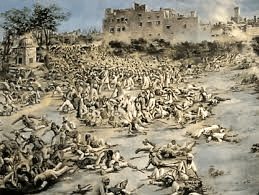After the Lucknow Pact of 1916 both Hindus and Muslims started their struggle for the self-rule for India. It was a brief period of Hindu-Muslim unity. To probe into their secret activities, the British Government formed a committee headed by Justice Sidney Rowlatt. Rowlatt presented his report to the Government on 30 April 1918 and as a result the Government introduced a bill in the Imperial Legislative Council known as the ‘Rowlatt Bill’ that gave unlimited powers to the administration and the police. The accused had no right to appeal or employ a lawyer for his defence. The Government was authorized to put any individual under house arrest without assigning any reason.
During the First World War the Indians had made great sacrifices for the British and expected that in compensation of their services the British Government would grant self-government to them but on the contrary they got no reward but penalty in the shape of ‘Rowlatt Act’. When the bill was presented before the Imperial Legislative Council, all the 23 non-official members voted against it; among these members were those who were very loyal to the Government. However, despite the whole opposition and protest the bill was passed and was decreed as ‘Rowlatt Act’. As protest Quaid-i-Azam resigned from the Imperial Legislative Council.
Strikes started all over India and M. K Gandhi also launched his non-violence movement. At that time Sir Michael O’ Dwyer, the Governor of Punjab had a strong hatred for the Indians and even determined to exert British dominance by all means. He was of the view that the British, which had seized the government by force, could preserve it only with force. For that matter he banned all public meetings, processions and protests in the province. To curb the political unrest in Punjab the Government banned the two well-known leaders of Amritsar, Dr Saifuddin Kitchlew and Dr Satyapal from making speeches. Later on they were arrested and sent to Dharamsala. The news of their arrest spread like wild fire and left the whole city in panic. On 9 April 1919, a large crowd gathered in a park demanding the release of their leaders. The police even opened fire to disperse the crowd. On 10 April, General Dyer received orders to leave Jalundhar for Amritsar. He reached Amritsar with 475 English and 710 Indian soldiers and two armored vehicles.
On the morning of April 13, he toured around the city and made announcements at 19 places that all the public meetings and processions had been banned and in case these orders are defied, use of force would not be ruled out. When General Dyer was told that a meeting was being held at Jallianwala Bagh, he reached there instantly with 90 troops and ordered them to open fire on the unarmed gathering. The firing continued for fifteen minutes and left 379 people dead on the spot and more than 1200 critically injured.
General Dyer believed that the event of Jallianwala Bagh was a part of the conspiracy in which the Indians were involved to overthrow the British Government. But the Hunter Committee had arrived at the conclusion that the riots in Amritsar including the meeting at Jallianwala Bagh weren’t the part of any planned conspiracy to overthrow the British Government. After the massacre at Jallianwala Bagh martial law was imposed in the Punjab and all the citizens of Lahore were ordered to hand over all their vehicles, bicycles, lamps and fans to the military. Martial law orders were pasted on the walls of the houses of prominent persons including Fazl-e-Hussain, Pir Tajuddin and Khalifa Shujauddin. The Principal of Dyal Singh College was punished only because someone had pasted an anti-martial law placard on the college wall. Moreover, water and power connections were cut off at various places of Punjab especially Lahore.
The public opinion in England was divided into two groups regarding the brutal tactics used by General Dyer. One group considered it a timely action to teach a lesson to the Indian whereas in view of the second group the tragedy at Amritsar had played a vital role in arousing the nationalistic feelings among the Indians. On the whole, the massacre at Jallianwala Bagh shattered into pieces once for all the tradition of loyalty to the British Crown. And within a period of 27 years, it was proved that the brutal acts of General Dyer and Lt. Governor O’ Dwyer could not suppress the passion for independence that flared up after the above episode.
This article was last updated on Monday, Jan 01, 2007






